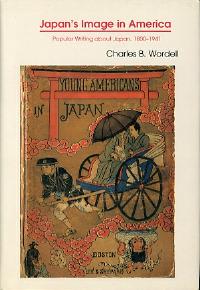When Japan comes to mind
By Mark Schreiber
A version of this review appeared inTokyo Journal, 1998
See also Japan's Image in America.

A review of Anyone who has watched locally produced movies or TV dramas has no doubt marveled at the surrealistic and occasionally bizarre ways in which Japanese recreate foreigners, particularly Americans, to suit their own image. Before pointing an accusatory finger, however, we would be well advised to look at the strange and wondrous portrayals of Japan that American popular writers have been churning out for the past two centuries. The work under review does just that. Dr. Wordell, an associate professor of British and American Studies at Nanzan University in Nagoya, has drawn upon a surprisingly rich body of sources to produce a chronology of American popular writings on Japan spanning the period from 1800 to the eve of World War II. Wordell has adopted a framework of six sections to reflect Japan's rising in and falling out of American favor--a pattern that has continued to the present. Along the way, he provides readers with a balance of solid historical details and some very astute analysis. In one passage, for example, he cites a late 18th century novel on the exploits of Daniel Boone on the U.S. frontier and compares this with fictitious accounts appearing a century later about young Americans who traveled to the Far East. Both encompassed such qualities as the pioneering spirit, America's "manifest destiny," and, of course, adventurous encounters with "people of color" who, while semi-civilized, were capable of erupting into acts of great savagery. The 1885 Gilbert and Sullivan operetta The Mikado, a smash hit in the U.S. after its introduction in Britain, fanned the public's curiosity about Japan and inspired numerous spinoffs which applied a formula of cowboy-meets-samurai and Yank-seduces-geisha. Of the substantial body of literature on Japan published around the turn of the century, few achieved any real distinction; but their impact helped establish Asia and Asians as exotic and inscrutable. The persistence of such formulas is fully evident in such contemporary bestsellers as Eric Van Lustbader's "ninja" thrillers. When interviewed in People magazine, Lustbader remarked that he purposely refrained from visiting Japan, since he feared the reality would spoil the image he had created in his own mind! Yet a few works of enduring quality did appear. The macabre and grotesque tales of Lafcadio Hearn, who arrived in Japan in 1890, remain eminently readable today. Among works less familiar to today's readers were those by Winnifred Eaton Babcock, a Eurasian who, under the nom de plume of Onoto Watanna, produced a string of popular novels set in Japan. Her books, which integrated love stories with historical settings, gave a racial and cultural perspective to the narrative--relatively enlightened attitudes for those times. "While Babcock demonstrated sensitivity to Japan," writes Wordell, "she did not extend sympathy to the social institutions that characterized and sustained the nation, [which] came under indiscriminate attack." For a multitude of reasons, that attitude has remained remarkably consistent, even in the present era of political correctness. In the book's final section, "Japan Challenges America," Wordell introduces Mr. Moto, novelist John page Marquand's intrepid secret agent, and compares his treatment with that of two Asians who appeared in fiction several decades earlier: Fu Manchu and Charlie Chan. Although not mentioned in the book, Moto, Chan and Fu Manchu were all supposed to have been based on real persons. Sax Rohmer insisted Fu Manchu was based a "Mr. King" who controlled Chinese crime in Limehouse, London's Chinatown; Chan was inspired by Earl Derr Biggers through a Honolulu newspaper account of a local policeman named Chang Apana. And Marquand is said to have pattered the character of Mr. Moto after the Japanese policeman assigned to "watch" him during his sojourn in Japan. The quintessence of the "Yellow Peril" has alternated between Japan and China over the years, and the greatest irony, of course, is that Japan's expansion in China in the 1920s and '30s moved U.S. writers to adopt an increasingly negative slant toward Japan. It's a shame Wordell could not have devoted more space comparing the treatment of Chinese and Japanese, particularly since the body of Anglo-American literature on China is both far more extensive than Japan, and considerably harsher in its treatment of Chinese. The author's strategy to end his chronology in 1941 was a sensible approach, since after Pearl Harbor popular writings merged with wartime propaganda, creating, and perpetuating, even more muddled stereotypes that are still alive and well. By 1994, Tom Clancy, master of the "techno-thriller," is spinning tales about a Japanese pilot crash-diving a 747 jumbo jet kamikaze-like into the dome of the U.S. Congress. Accompanied by several pages of fascinating old illustrations, this work both highly informative and entertaining. For anyone who really wants to understand why Americans think the way they do about Japan, it comes highly recommended. |